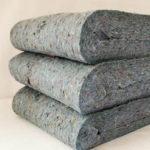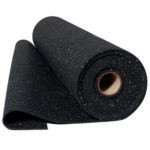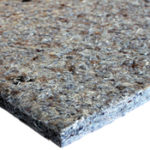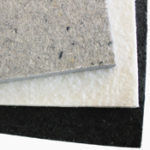
Unwanted noise in any room can be disruptive or make it challenging to concentrate. As you consider soundproofing to improve the acoustics of your space, Noise Reduction Coefficient (NRC) ratings are likely to come up. This guide covers everything you need to know.
The Basics of NRC Ratings
Simply put, an NRC rating describes how effective a material is at absorbing sound, which also determines how much quieter it can make your space. Understanding NRC ratings is essential for selecting materials that improve your control over your acoustic environment.
What Is NRC?
NRC is a single-number rating determined in a lab test, generally ranging from 0.00 to 1.00, that indicates how absorptive a material is. An NRC of 0.0 means the material perfectly reflects sound, while 1.0 means the material absorbs all sound. The rating represents the average sound absorption of a material across midrange frequencies.
How NRC Is Measured
NRC is calculated using the American Society of Testing and Materials (ASTM) C423 test method, which measures sound absorption in a reverberation room. The chamber is designed with hard walls, floors and doors to reflect nearly all sound.
Before the test material is brought in, a sound is produced in the chamber, and testers measure the time it takes for the sound to be absorbed. Once the initial measurement is taken, the material being tested is brought in, and the process is repeated.
The sound absorption of the material is measured at specific frequencies in hertz (Hz), or cycles per second. Typical frequencies are 250 Hz, 500 Hz, 1000 Hz and 2000 Hz. The average of the sound absorption coefficients at those frequencies is then rounded to the nearest 0.05 to produce the final NRC value.
Understanding the NRC Scale
The NRC scale ranges from values 0.00 to 1.00. As already established, the higher the NRC rating for sound, the more absorptive the material. To better understand this scale practically, consider different materials with varying NRC ratings.
For instance, painted, smooth concrete typically has an NRC of 0.00 to 0.05. Unpainted concrete can range up to 0.20, in which case most sound reflects off the surface.
On the other hand, materials like carpet and acoustic panels can have ratings that range from 0.30 to 0.55, which means they provide better sound absorption and contribute to a quieter room.
Why NRC Ratings Matter
NRC ratings are a great way to determine the performance of an acoustic material, mainly how well it absorbs sound. The rating varies with different products, so knowing what a good NRC rating is starts with an assessment of the room’s function and your needs.
Using materials with appropriate NRC ratings offers several benefits, including:
- Improved speech intelligibility: Choosing acoustic materials with a good NRC rating can improve speech intelligibility by significantly reducing echo and reverberation. As a result, spoken words will not overlap and become muffled or create repeated sounds. The materials can also absorb background noise to enhance clarity.
- Reduced noise levels: The right NRC-rated material can lower the noise levels in your space by preventing sound from reflecting off surfaces and minimizing disruptive echoes and reverbs.
- Enhanced speech privacy: Using materials with a suitable NRC helps control the spread of speech within a room, improving privacy and making conversations clearer.
- Better acoustic comfort: Without reverbs and unwanted noise, appropriately NRC-rated materials can create a more comfortable and pleasant environment for occupants.
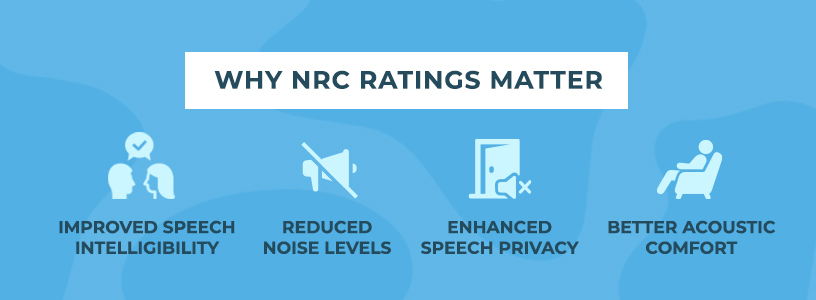
Common Applications of NRC Ratings
NRC ratings value the sound-absorbing qualities of materials in environments where reducing echo and improving speech clarity are crucial. NRC-rated products are often used as acoustic ceiling tiles, fabric-wrapped wall panels, suspended baffles and other materials designed to blend in.
Some spaces where acoustic NRC rating materials are commonly used are:
- Offices
- Schools
- Home theaters
- Recording studios
- Restaurants
- Gymnasiums
The Limitations of NRC and Other Ratings to Consider
While great for determining a material’s sound absorption capabilities, NRC noise ratings have several limitations. NRC is only one of many factors to consider in acoustic design. You will need to balance multiple metrics to improve the acoustics in a room and achieve the desired sound environment, including:
- Sound Transmission Class (STC): The STC rating measures a material’s ability to block the transmission of sound from one space to another. It indicates how well a partition, like a wall or ceiling, can block sounds. A higher rating means more sound is blocked from going through the material.
- Impact Insulation Class (IIC): The IIC rating measures how well a floor-ceiling assembly reduces impact noise, such as footsteps or objects dropping. The higher the IIC rating, the more effective the assembly is at blocking this noise from traveling between floors.
- Reverberation Time (RT60): Reverberation time, otherwise referred to as RT60, measures the time it takes for sound to decay by 60 decibels within a room — in other words, how long a sound takes to go from full volume to silence. This metric helps determine if a room’s acoustics are suitable for the intended purpose, like music, speech or performances. A short RT60 can make words crisp and clear.
An NRC rating is also an average value and does not represent a material’s performance at all frequencies. It is a single-number rating that simplifies a product’s acoustic performance for quick comparison. Since it is an average, two materials with the same NRC rating can have very different absorption profiles across the frequency spectrum.
Choosing Materials Based on NRC Ratings
As you start your soundproofing project, you may wonder what a good NRC rating is for your needs. It is easy to assume that a higher NRC rating is the best option since it offers greater sound absorption, but that is not always true. When choosing materials based on NRC ratings, you need to account for room size, intended use and desired acoustic environment, among other factors.
Consulting with an acoustic specialist is best, especially for larger, complex projects. They will assess your needs and provide the necessary guidance to help you make the right choice.
Enhance Room Acoustics With Soundproof Cow
Understanding what an NRC rating is can help you create the ideal sound environment. At Soundproof Cow, we know the importance of using materials with the right NRC rating to effectively manage sound within an indoor environment. Our experts can help you choose the most suitable sound-absorbing solutions. Contact us online today to start your project.





